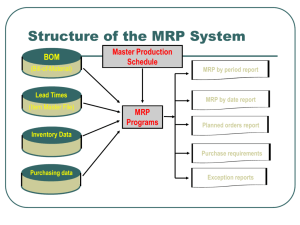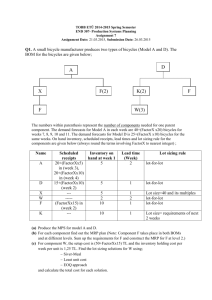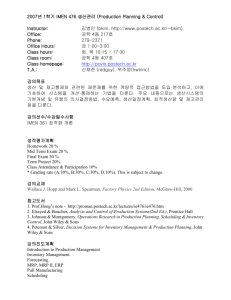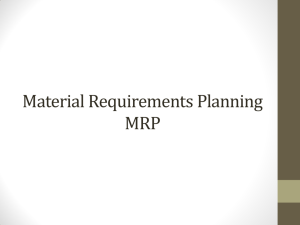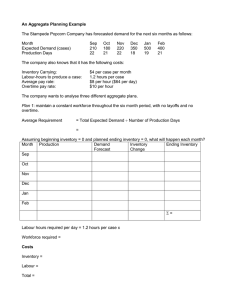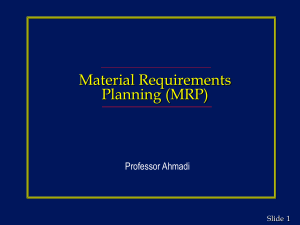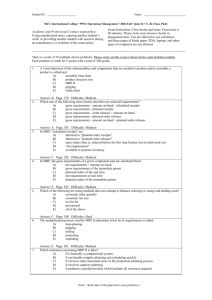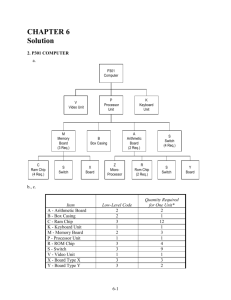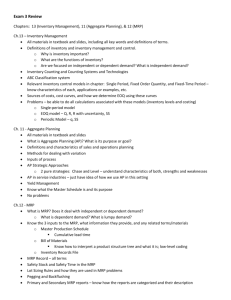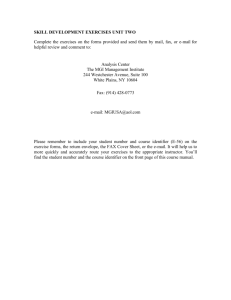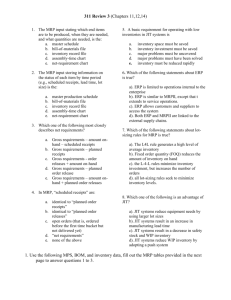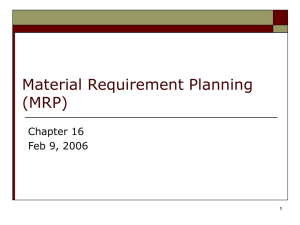Material and Capacity Planning
advertisement
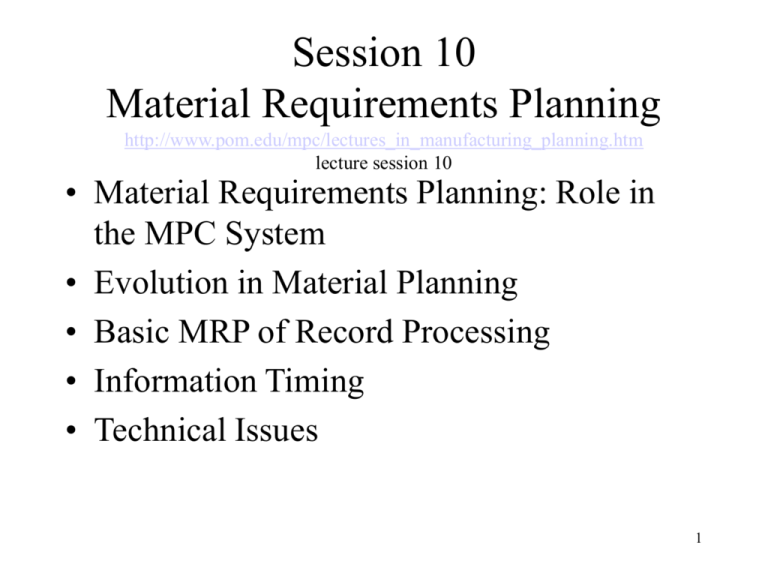
Session 10 Material Requirements Planning http://www.pom.edu/mpc/lectures_in_manufacturing_planning.htm lecture session 10 • Material Requirements Planning: Role in the MPC System • Evolution in Material Planning • Basic MRP of Record Processing • Information Timing • Technical Issues 1 Manufacturing Planning and Control System 2 Evolution in Material Planning • • • • • Independent vs. Dependent Demand Items MRP Closed loop MRP systems MRP II (Manufacturing Resource Planning) ERP 3 Basic MRP Records and Record Processing: Example Develop an MRP spreadsheet record for six periods using the following parameters for the item: Period Gross requirements Lead time Lot size Safety stock Inventory Scheduled receipt 1 20 2 20 3 4 20 30 1 period 40 units 0 units 2 units 40 units in period 1 5 30 6 30 4 Basic MRP Records and Record Processing: Example (Continued) a. In what periods are there planned order releases? b. What happens to the timing, number of planned order releases, and average inventory (for periods l through 6) if 10 units of safety stock are required? c. What happens to the timing, number of planned order releases, and average inventory (for periods 1 through 6) if a one-period safety lead time is used instead of the safety stock? 5 Basic MRP Records and Record Processing a. No safety stock Period Gross Requirements Scheduled Receipts Projected Available Balance Planned Order Release Q = 40, LT = 1, SS = 0 2 1 20 40 22 2 20 3 20 4 30 5 30 6 30 2 40 22 40 32 2 40 12 Three planned orders in periods 2, 3, and 5. Average projected inventory is 15.33 units. 6 Information Timing Gross Requirements Scheduled Receipts Projected Available Balance Planned Order Release - Beginning of Period Beginning of Period End of Period Beginning of Period 7 Basic MRP Records and Record Processing (Continued) b. Safety stock of 10 units Period Gross Requirements Scheduled Receipts Projected Available Balance Planned Order Release 2 1 20 40 22 40 2 20 3 20 4 30 5 30 6 30 42 22 40 32 40 42 12 Q = 40, LT = 1, SS = 10 Three planned orders in periods 1, 3, and 4. Two planned orders were moved up because of the safety stock requirement. Average projected inventory is 28.67 units. 8 Basic MRP Records and Record Processing a. No safety stock Period Gross Requirements Scheduled Receipts Projected Available Balance Planned Order Release Q = 40, LT = 1, SS = 0 2 1 20 40 22 2 20 3 20 4 30 5 30 6 30 2 40 22 40 32 2 40 12 Three planned orders in periods 2, 3, and 5. Average projected inventory is 15.33 units. 9 Basic MRP Records and Record Processing (Continued) c. Safety Lead Time of 1 period Period 1 2 Gross Requirements 20 20 Scheduled Receipts 40 Projected Available Balance 2 22 42 Planned Order Release 40 40 Q = 40, LT = 1, SS = 0, SLT = 1 period 3 20 4 30 5 30 6 30 62 32 40 42 12 Three planned orders in periods 1, 2, and 4. All of the planned orders were moved up by 1 period to account for the safety lead time. Average projected inventory is 35.33 units. Using safety stocks or safety lead time causes the system to hold more inventory and order earlier. The safety lead time causes all orders to be held an extra period in inventory 10 Technical Issues • Net Requirements • Lot Sizing – Lot-For-Lot (L4L) – Fixed Order Quantities (Q) • Safety Stock and Safety Lead Time • Incorporating Service Part Demand • Scheduled Receipts versus Planned Order Releases • Firm Planned Orders 11
